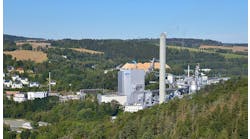By Béla Lipták, PE
To find the right combination of pumps, start by first determining the prevailing power consumption being consumed at the particular operating load. If smart pumps are used, the power consumption can also be indirectly calculated on the basis of the detected pump velocity and pressure differential. Once the prevailing total flow and corresponding total power consumption are known, check the predictive model to see if there might be another pump combination that will meet the total flow requirement at a lower power consumption. By the use of this model predictive approach, the pump combination that consumes the least amount of power can be identified and implemented (see Figure below). Therefore, a model predictive controller (MPC) can be programmed to find the optimum pump selection by summing the required power consumption for any pump combinations at any load. COMPARE THE ALTERNATIVES
Using the coordinates of flow, pressure and speed, pump characteristics can be described by a three-dimensional surface and the process system the pump serves can be described by another surface. When multiple variable-speed pumps operate in parallel, their characteristic surfaces are summed in the direction of the flow coordinate to obtain their combined characteristic surface.
The operating line of a multiple-pump pumping station which is serving a particular process can be found where the two characteristic surfaces meet (see Figure below). A power consumption surface corresponds to the operating surface of the pump or pump station. When the pumping station consists of a large number of pumps (both constant and variable speed), the goal is to meet any load with a combination of pumps that will consume the least amount of power.
Smart Pumps and Pump ModelsThe operating line of a multiple-pump pumping station which is serving a particular process can be found where the two characteristic surfaces meet (see Figure below). A power consumption surface corresponds to the operating surface of the pump or pump station. When the pumping station consists of a large number of pumps (both constant and variable speed), the goal is to meet any load with a combination of pumps that will consume the least amount of power.
To find the right combination of pumps, start by first determining the prevailing power consumption being consumed at the particular operating load. If smart pumps are used, the power consumption can also be indirectly calculated on the basis of the detected pump velocity and pressure differential. Once the prevailing total flow and corresponding total power consumption are known, check the predictive model to see if there might be another pump combination that will meet the total flow requirement at a lower power consumption. By the use of this model predictive approach, the pump combination that consumes the least amount of power can be identified and implemented (see Figure below). Therefore, a model predictive controller (MPC) can be programmed to find the optimum pump selection by summing the required power consumption for any pump combinations at any load. COMPARE THE ALTERNATIVES
The model-predictive controller (MPC) selects the optimum pump combination by comparing all alternative options and selecting the one which requires the least power.
An added advantage of modeling characteristic pump surfaces is the ability to also check for NPSH availability. While much of this data can be condensed in look-up tables, this is not really necessary because the MPC can do the optimizing in real time and can adapt and modify its own model as equipment or process conditions change.Combined with surge-free pump starts and stops and inherent predictive maintenance capability, MPCs can also improve overall plant operation. In addition, they can reduce or eliminate the need for storage, and can improve safety if the particular storage volumes are hazardous in confined spaces. Each model-based application can contribute to a program shell that can be reused, so that the development cost is amortized across many applications. This approach should eventually lead to a user-configurable, all-purpose pumping station optimizer.
You should also remember that pump optimization is one of hundreds of other unit operations that hold optimization opportunities. Pump optimization is only one subchapter in my handbook which contains 175 similar sections.ISA should take the leading role in not only developing the first general-purpose unit operation controllers, but in educating the general public about the potential of process control and automation in maintaining our competitive edge. This role of a professional society is very important, because neither the users nor the vendors can fulfill this role.The users can only be expected to plug into the unit operations controllers the characteristics of their equipment and their process. They can not be expected to develop mathematical models, understand the tuning of velocity and positional algorithms or the peculiarities of external resets, interactions and relative gains. That is not their job. Their job, in the case of a pumping station, is to plug in the system curve and the characteristics of each of their pumps and to push the start button.The same holds true for the PC, PLC, DCS and other vendors of our digital Tower of Babel. Their job is not to learn all the peculiarities of our processes and of the equipment we use. Their job is to provide fast, safe and accurate hardware with good visual displays, that are flexible enough to accept our digital and analog I/O and our software programs for logic, optimization, self diagnostics, auto-start/stop and all other functions that will fulfill the needs of our unit processes.The task that remains for the professional societies, such as ISA, is to develop the universal software package for each unit operation in our industries. It is high time that we stopped controlling flows, pressures and temperatures. It is time to start controlling and optimizing pumping stations, boilers and chemical reactors.RELATED ARTICLES
The hard road to our competitive edge, Part IThe hard road to our competitive edge, Part IIBéla Lipták, PE, process control consultant, is also editor of the "Instrument Engineers' Handbook" and is seeking new co-authors for the forthcoming new edition of that multi-volume work. He can be reached at [email protected].
An added advantage of modeling characteristic pump surfaces is the ability to also check for NPSH availability. While much of this data can be condensed in look-up tables, this is not really necessary because the MPC can do the optimizing in real time and can adapt and modify its own model as equipment or process conditions change.Combined with surge-free pump starts and stops and inherent predictive maintenance capability, MPCs can also improve overall plant operation. In addition, they can reduce or eliminate the need for storage, and can improve safety if the particular storage volumes are hazardous in confined spaces. Each model-based application can contribute to a program shell that can be reused, so that the development cost is amortized across many applications. This approach should eventually lead to a user-configurable, all-purpose pumping station optimizer.
ISAs Role
Returning to the topic of outsourcing and the potential for regaining our competitive edge through technical innovation, you might say that the number of jobs created by designing optimized pumping stations is small, compared to the job losses caused by outsourcing. Yet, if you sit down and calculate the number of pumping stations in operation and the effort their optimization would take in terms of manufacturing the control hardware, writing the software, designing the individual applications and installations, you might be surprised.
|
ISA should take the leading role in not only developing the first general-purpose unit operation controllers, but in educating the general public about the potential of process control in maintaining our competitive edge. |
The hard road to our competitive edge, Part IThe hard road to our competitive edge, Part IIBéla Lipták, PE, process control consultant, is also editor of the "Instrument Engineers' Handbook" and is seeking new co-authors for the forthcoming new edition of that multi-volume work. He can be reached at [email protected].




